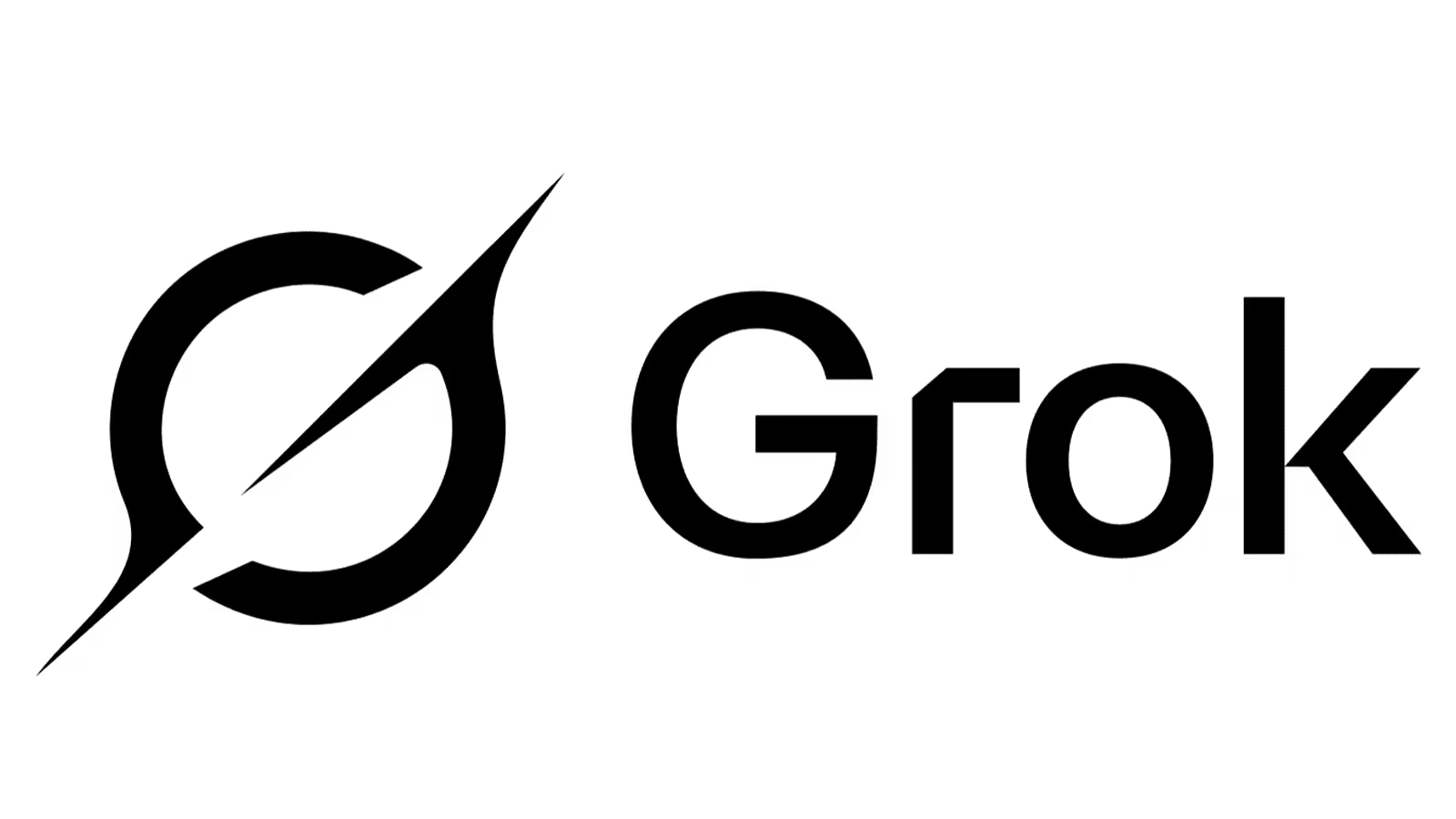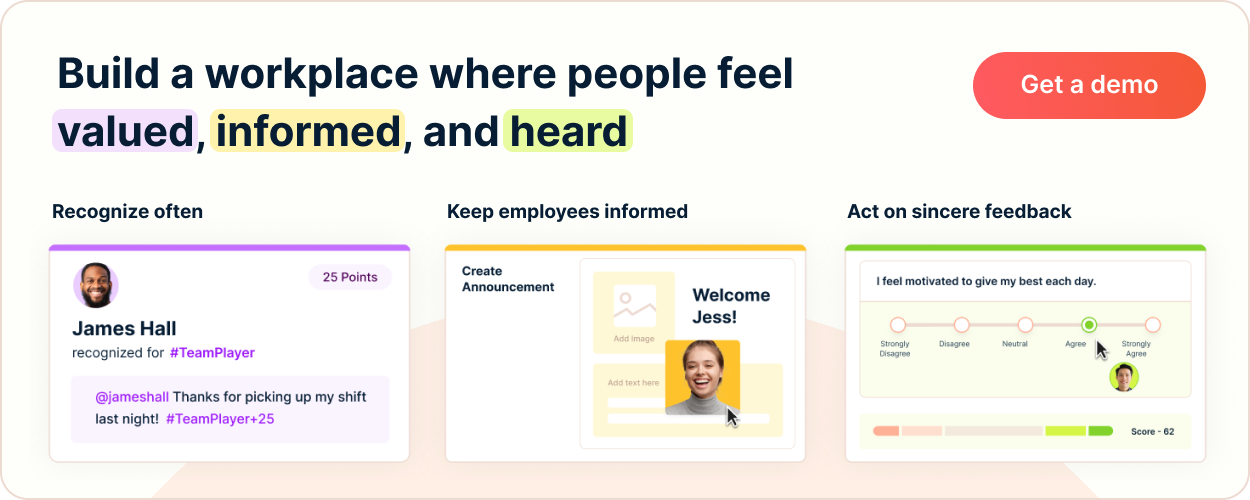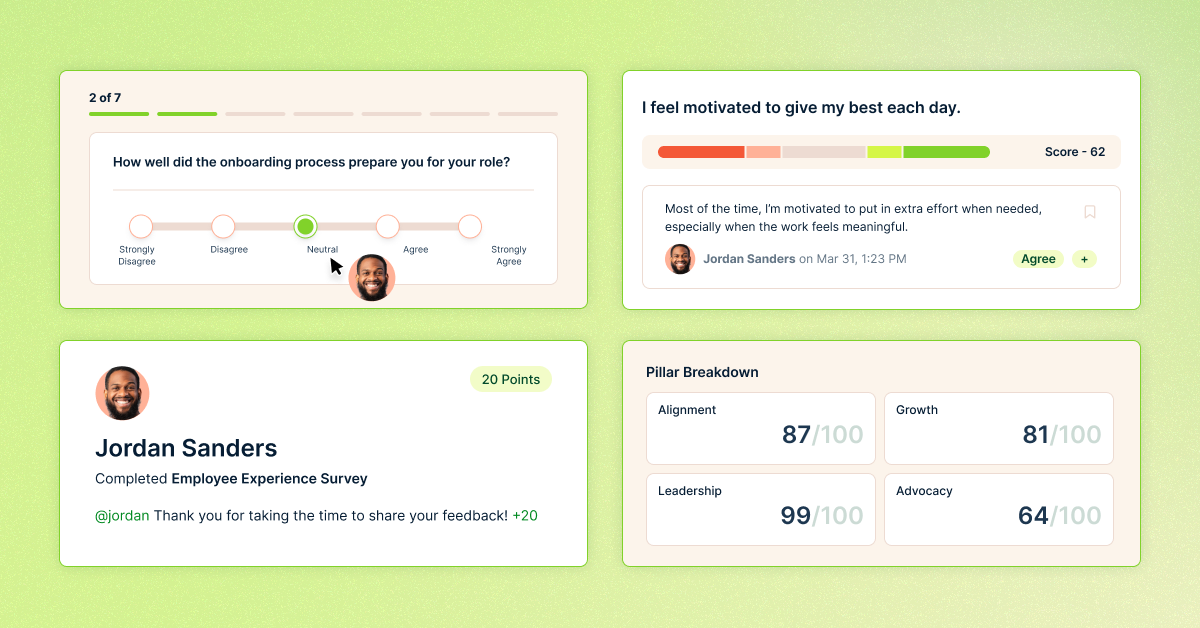How to Address and Improve Low Morale in the Workplace

Here's the TL;DR
Low employee morale can lead to reduced engagement, productivity, and retention. It often stems from poor communication, lack of recognition, unclear career paths, or organizational change. To address low morale, companies must first measure it through a mix of tools like pulse surveys, engagement assessments, performance trends, and employee sentiment analysis. These methods help identify underlying issues and give employees a safe space to share honest feedback.
Once morale issues are diagnosed, companies can take focused action. The article outlines 22 strategies to rebuild and maintain strong morale, categorized into four main themes:
Communication and Feedback
- Conduct regular pulse surveys and act on responses
- Use anonymous feedback tools and ensure visible follow-up
- Foster a culture of transparency and consistent communication
Recognition, Respect, and Trust
- Implement employee recognition programs (peer-to-peer, points-based, public shout-outs)
- Allow autonomy and flexible schedules
- Build psychological safety and emotional openness
Career Growth and Leadership
- Create clear career paths and promote internally
- Provide ongoing leadership training for managers
- Redefine roles clearly, especially during periods of change or layoffs
Workplace Culture and Wellbeing
- Schedule regular team-building activities (virtual and in-person)
- Support mental health through PTO, recharge days, and wellbeing benefits
- Encourage social connection, trust, and a sense of belonging
Improving morale isn’t a quick fix. Leaders should start by identifying the most relevant areas for their teams and commit to small, consistent improvements over time.
In 2019, a major North American distribution company faced an unsettling reality: turnover rates among its product handlers had reached unsustainable levels. These were not isolated incidents but part of a broader pattern tied to low morale. Employees, burdened by repetitive tasks and minimal pay, reported disengagement and dissatisfaction in anonymous surveys. Managers, meanwhile, struggled to reconcile their perception of “good morale” with the clear signs of negativity—high absenteeism, reduced productivity, and a growing disconnect between workers and leadership.
The consequences were immediate and measurable. Productivity slowed, errors increased, and the cost of constant rehiring strained operational budgets. Yet, the root causes—poor communication, lack of motivation, and inadequate supervision—remained unaddressed.
This case is not unique. Across industries, low morale quietly erodes workplace efficiency and culture. Understanding its origins and implementing targeted interventions is not just a managerial challenge but a necessity for organizational survival.

Image source: betterup.com
Signs and Symptoms of Low Morale
One of the most telling yet often overlooked indicators of low morale is increased absenteeism and lateness. While these behaviors are frequently attributed to personal issues, they often signal deeper organizational problems. For instance, a 2021 internal review at Amazon’s fulfillment centers revealed that absenteeism rates spiked by 15% in facilities where employees reported feeling undervalued and overworked. This absenteeism not only disrupted workflows but also increased the burden on present staff, further compounding dissatisfaction.
The root cause often lies in poor communication and lack of recognition. A Gallup study found that employees who feel ignored by their managers are 2.6 times more likely to be actively disengaged. This disengagement manifests as reduced enthusiasm, minimal collaboration, and a reluctance to take initiative. For example, at Zappos, a shift toward transparent communication and peer-to-peer recognition programs led to a 20% improvement in employee satisfaction scores within a year.
To address absenteeism effectively, organizations can implement real-time feedback systems and flexible scheduling policies. These measures not only provide employees with a sense of agency but also allow managers to identify and resolve issues proactively. By fostering a culture of open dialogue and appreciation, companies can transform absenteeism from a symptom of low morale into an opportunity for engagement and growth.
Common Misconceptions About Low Morale
A prevalent misconception is that low morale stems solely from individual employee attitudes, ignoring systemic organizational issues. This oversimplification often leads to ineffective solutions, such as superficial team-building activities, which fail to address root causes like poor leadership or unclear communication.
For example, a 2022 study by Gallup revealed that 70% of morale variance is directly linked to managerial behavior. At Microsoft, a shift from micromanagement to empowering team autonomy resulted in a 25% increase in employee engagement within six months. This demonstrates that addressing leadership styles can yield measurable improvements.
Another overlooked factor is the impact of workplace culture on morale. Companies like Patagonia, which prioritize inclusivity and purpose-driven work, report consistently high employee satisfaction. This suggests that fostering a culture aligned with employee values is critical.
Organizations should adopt a morale diagnostic framework, combining anonymous surveys, leadership evaluations, and cultural audits, to identify and address systemic issues effectively.
Identifying the Root Causes of Low Morale
Understanding the root causes of low morale requires moving beyond surface-level symptoms to uncover systemic issues. One critical factor is poor communication, which creates a ripple effect of misunderstandings and disengagement. For instance, a Deloitte study found that 79% of employees who trust their employers feel motivated, compared to only 29% who don’t. This highlights how transparent communication fosters trust and morale.
Another overlooked cause is workload imbalance. Excessive workloads lead to burnout, while insufficient challenges result in boredom and disengagement. At Google, implementing flexible project assignments allowed employees to align tasks with their strengths, reducing stress and boosting satisfaction.
Leadership behavior is perhaps the most significant driver. A Gallup study revealed that 70% of morale variance is tied to managerial practices. Contrastingly, companies like Netflix, which emphasize autonomy and trust, report higher employee engagement.
To address these issues, organizations should adopt root-cause analysis frameworks, combining employee feedback, workload audits, and leadership evaluations. This approach ensures targeted interventions that rebuild morale from the ground up.
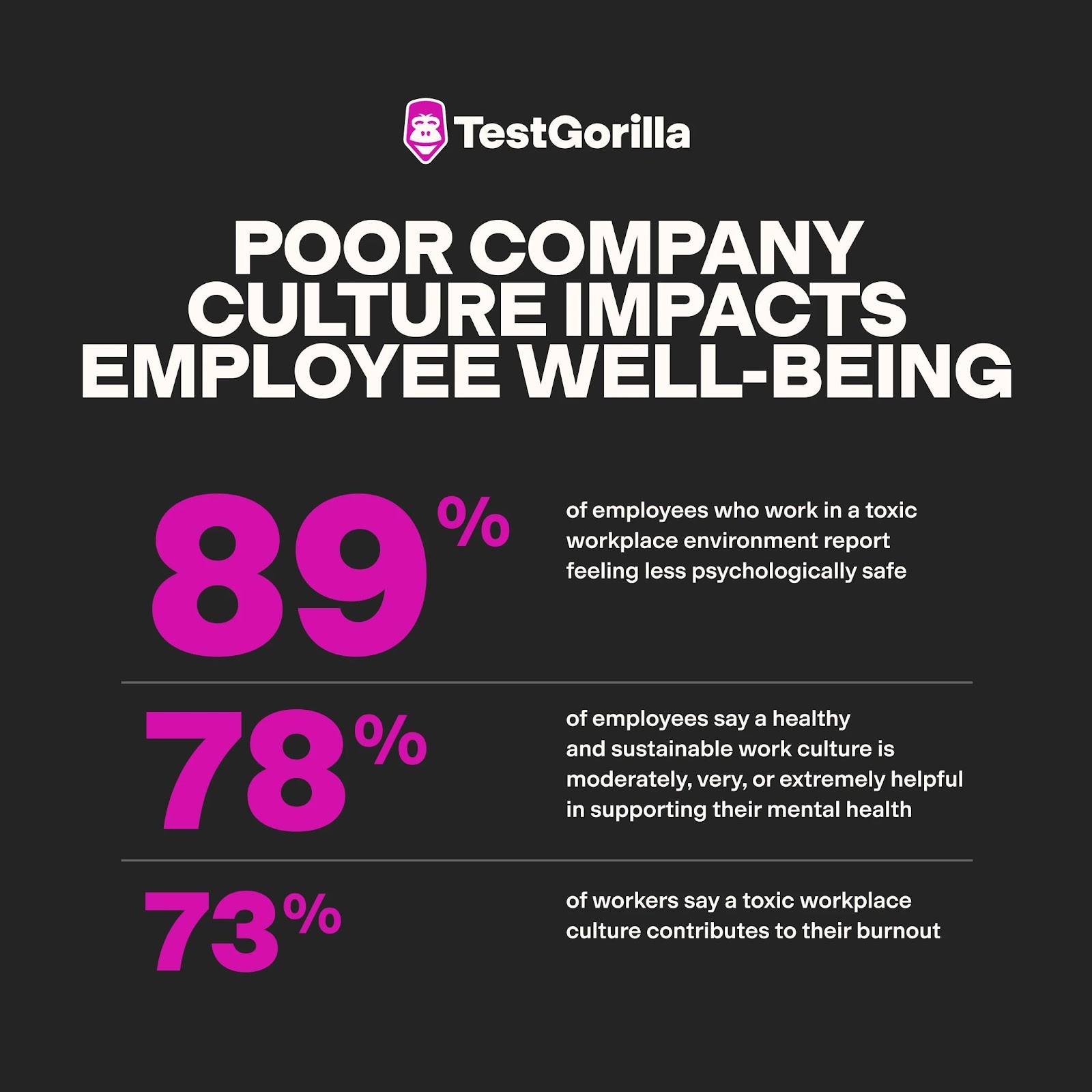
Image source: testgorilla.com
Analyzing Workplace Culture and Environment
Workplace culture profoundly shapes employee morale, yet its influence often goes unnoticed until issues arise. A critical aspect is inclusivity and diversity, which directly impacts employee engagement. Deloitte’s inclusion maturity model revealed that organizations with high inclusivity scores experienced a 30% increase in employee retention rates. This underscores the importance of fostering a culture where diverse perspectives are valued.
Another key factor is alignment between organizational values and employee expectations. Patagonia, for example, integrates environmental sustainability into its core mission, attracting employees who share these values. This alignment has resulted in consistently high satisfaction scores and a turnover rate 50% lower than the industry average.
To analyze culture effectively, organizations can implement a Cultural Alignment Index (CAI), combining metrics such as employee feedback, inclusivity audits, and value congruence surveys. For instance, companies scoring above 80 on the CAI often report higher innovation rates and lower absenteeism.
Emerging trends, such as the rise of remote work, further highlight the need for adaptable cultural strategies. Companies like GitLab, which prioritize asynchronous communication and transparency, demonstrate how tailored approaches can sustain morale in evolving environments.
By proactively addressing cultural gaps, organizations can create environments that not only mitigate low morale but also drive long-term success.
Impact of Leadership and Management Practices
Leadership and management practices are pivotal in shaping employee morale, with adaptive leadership styles emerging as a critical factor. Research by Gallup indicates that 70% of morale variance is directly linked to managerial behavior. Transformational leadership, which emphasizes trust, empowerment, and vision, has consistently demonstrated positive outcomes. For instance, Microsoft’s shift from micromanagement to team autonomy led to a 25% increase in employee engagement within six months.
A lesser-known but impactful approach is emotional intelligence (EI) in leadership. Leaders with high EI foster stronger relationships, reduce workplace stress, and enhance team cohesion. A study by Peoplesafe highlights that organizations investing in EI training for managers saw a 15% reduction in employee turnover and a 20% improvement in team productivity.
To quantify leadership impact, organizations can adopt a Leadership Effectiveness Index (LEI). This metric integrates employee feedback, team performance data, and retention rates to evaluate managerial influence on morale. Companies scoring above 85 on the LEI, such as Zappos, report higher employee satisfaction and innovation levels.
Emerging trends, like hybrid work models, demand flexible leadership strategies. GitLab’s emphasis on asynchronous communication and transparent decision-making showcases how tailored management practices can sustain morale in distributed teams.
Challenging conventional wisdom, evidence suggests that servant leadership, which prioritizes employee well-being over short-term results, drives long-term success. By embedding empathy and inclusivity into leadership frameworks, organizations can create resilient, high-morale environments that adapt to evolving challenges.
Strategies to Improve Workplace Morale
Improving workplace morale requires a multifaceted approach that addresses both systemic issues and individual needs. One effective strategy is real-time feedback systems, which empower employees by fostering open communication. For example, Adobe replaced annual performance reviews with regular check-ins, resulting in a 30% reduction in voluntary turnover.
Another impactful method is peer-to-peer recognition programs. At Zappos, employees can publicly acknowledge colleagues’ contributions, creating a culture of appreciation. This initiative led to a 20% increase in employee satisfaction within a year, demonstrating the power of recognition in boosting morale.
A less conventional but highly effective approach is integrating charitable giving into workplace culture. Boston Beer Co. implemented a program allowing employees to vote on company-sponsored charitable initiatives, which not only improved morale but also strengthened team cohesion.
Addressing common misconceptions, it’s crucial to recognize that morale is not solely an individual issue but often reflects leadership and cultural dynamics. By combining transparent communication, flexible policies, and values-driven initiatives, organizations can create environments where morale thrives, driving both productivity and loyalty.
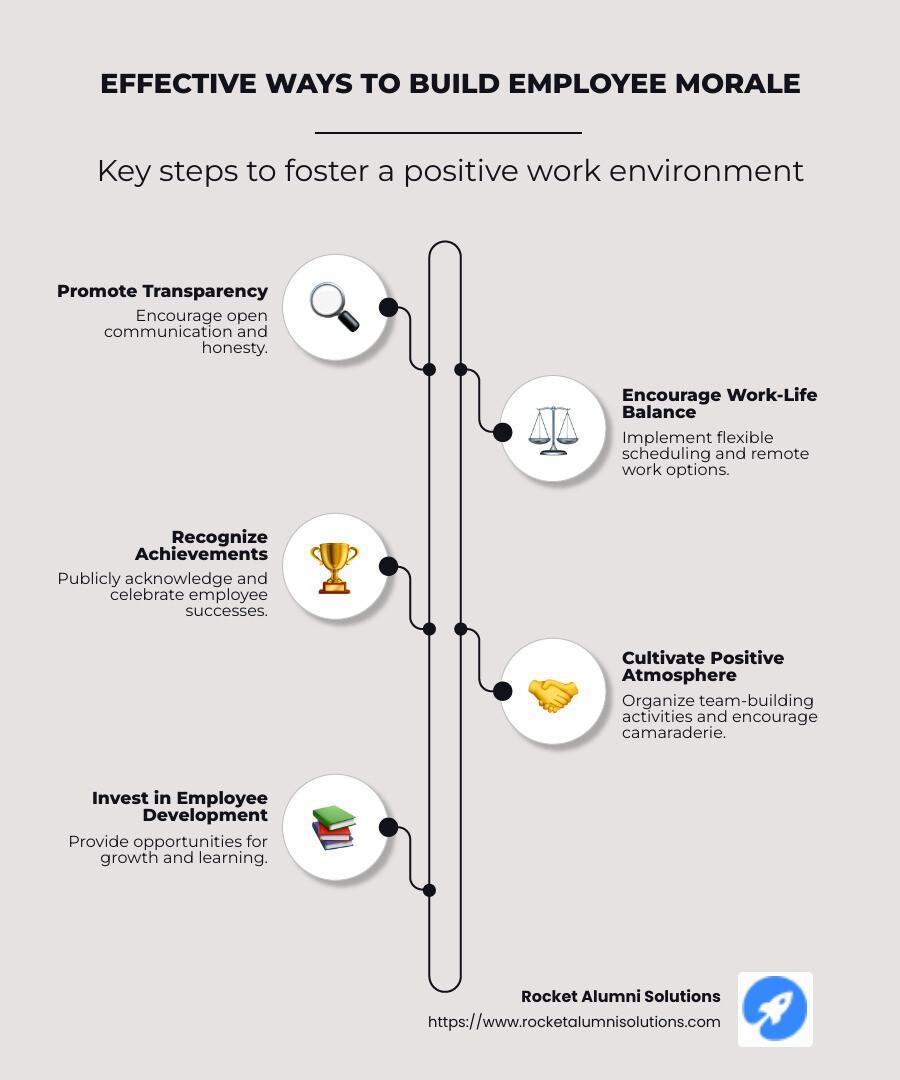
Image source: rocketalumnisolutions.com
Effective Communication and Feedback Mechanisms
A cornerstone of improving workplace morale is establishing effective communication and feedback mechanisms that foster trust and engagement. Research by Gallup reveals that employees are 3.6 times more likely to feel motivated when managers provide daily feedback compared to annual reviews. This underscores the importance of continuous feedback loops in maintaining morale.
One innovative approach is the Cultural Alignment Index (CAI), which measures the congruence between organizational values and employee expectations. Companies scoring above 80 on the CAI, such as Patagonia, report higher retention rates and employee satisfaction. By integrating feedback mechanisms into this framework, organizations can align communication strategies with cultural goals.
A compelling case study is Adobe’s transition to real-time feedback systems. By replacing traditional performance reviews with regular check-ins, Adobe reduced voluntary turnover by 30%. This shift not only improved morale but also enhanced productivity by addressing employee concerns promptly.
Emerging trends, such as hybrid work models, demand asynchronous communication tools. GitLab’s emphasis on transparency and asynchronous updates demonstrates how tailored communication strategies can sustain morale in distributed teams.
To future-proof morale strategies, organizations should adopt feedback ecosystems that combine real-time insights, inclusivity audits, and transparent action plans, ensuring employees feel valued and heard in dynamic environments.
Enhancing Employee Recognition and Rewards
A focused approach to employee recognition involves aligning rewards with organizational values and individual preferences. This strategy ensures that recognition feels authentic and meaningful, fostering deeper engagement. For instance, Zappos integrates peer-to-peer recognition programs that highlight employees who embody company values, resulting in a 20% increase in employee satisfaction within a year.
A unique model to consider is the Recognition Impact Index (RII), which evaluates the effectiveness of recognition programs by measuring employee engagement, retention rates, and productivity. Companies scoring above 85 on the RII, such as Boston Beer Co., report stronger team cohesion and a 15% reduction in turnover after implementing value-driven recognition initiatives.
Emerging trends emphasize digital recognition platforms. Tools like Connecteam allow managers to send personalized badges or digital tokens, which employees can redeem for rewards. This approach not only modernizes recognition but also ensures inclusivity in distributed teams.
Challenging conventional wisdom, recognition should extend beyond performance metrics to include efforts that promote well-being and collaboration. For example, Patagonia’s focus on work-life balance recognition has contributed to a turnover rate 50% lower than the industry average.
Looking ahead, organizations should adopt dynamic recognition frameworks that integrate real-time feedback, inclusivity audits, and employee-driven reward systems to sustain morale in evolving workplaces.
Promoting Work-Life Balance and Flexibility
A critical aspect of promoting work-life balance is offering flexible scheduling tailored to employee needs. This approach empowers workers to manage personal and professional responsibilities effectively, reducing stress and enhancing productivity. For example, Atlassian and Zapier, which provide unlimited remote work opportunities, consistently rank among top employers. These policies have fostered creativity and innovation, with Atlassian reporting a 32% increase in employee satisfaction.
To measure the impact of such initiatives, organizations can adopt the Work-Life Balance Index (WLBI). This metric evaluates employee well-being by analyzing absenteeism, turnover rates, and self-reported satisfaction. Companies scoring above 80 on the WLBI, such as GitLab, demonstrate higher retention and lower burnout rates, showcasing the tangible benefits of flexible policies.
Emerging trends highlight the importance of boundary-setting education. Encouraging employees to establish clear work-life boundaries, such as designated work hours, prevents role overload. For instance, Deloitte’s workshops on stress management have reduced employee burnout by 18% within a year.
Contrary to traditional beliefs, work-life balance is not a luxury but a productivity driver. Forward-thinking organizations should implement customized flexibility frameworks, combining remote work options, boundary-setting training, and WLBI tracking to sustain morale and long-term success.
Implementing and Monitoring Improvement Initiatives
Effective implementation of morale-boosting initiatives requires a structured, iterative approach. Organizations should begin with a pilot program, targeting a specific department or team to test strategies such as flexible scheduling or peer-to-peer recognition. For instance, Adobe’s transition to real-time feedback systems started with a small-scale rollout, which reduced voluntary turnover by 30% within a year.
Monitoring progress demands data-driven tools like the Cultural Alignment Index (CAI) or Work-Life Balance Index (WLBI). These metrics provide actionable insights by tracking employee satisfaction, absenteeism, and retention rates. Companies like GitLab, which score above 80 on the WLBI, demonstrate the effectiveness of continuous monitoring in sustaining morale.
A common misconception is that initiatives succeed solely through leadership directives. Instead, employee involvement in designing and refining programs ensures relevance and buy-in. Analogous to fine-tuning a musical instrument, regular feedback harmonizes organizational goals with employee needs, creating a resilient, high-morale workplace.
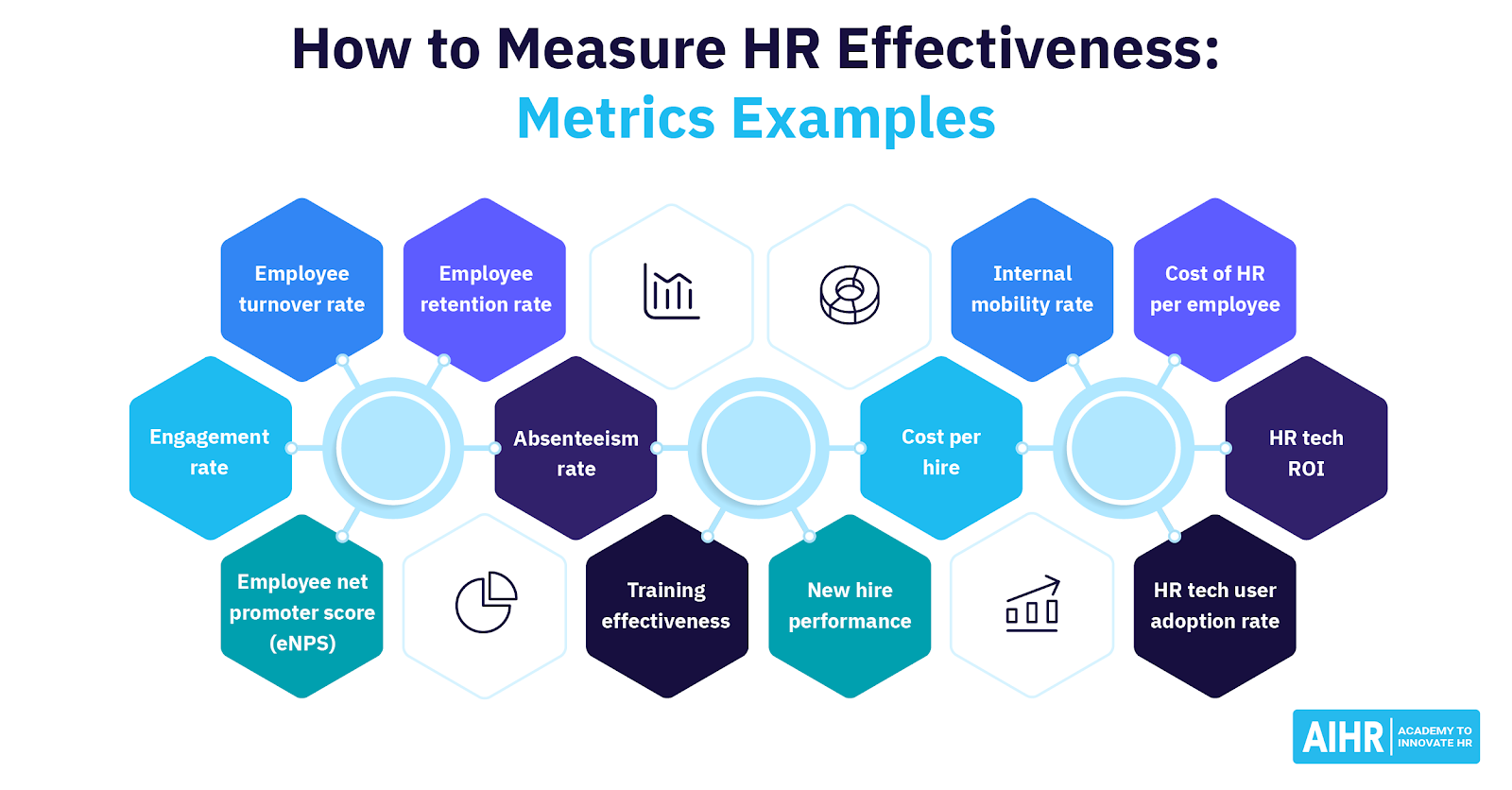
Image source: aihr.com
Utilizing HR Analytics and Feedback Tools
HR analytics and feedback tools are transformative in diagnosing and addressing low morale, particularly when integrated into a predictive engagement framework. By combining real-time feedback with advanced analytics, organizations can proactively identify morale dips before they escalate. For example, IBM leverages sentiment analysis from employee surveys to detect early signs of disengagement, enabling targeted interventions that have reduced turnover by 20%.
A unique model is the Engagement Predictive Index (EPI), which aggregates metrics like absenteeism, feedback sentiment, and productivity trends. Companies scoring above 85 on the EPI, such as Google, report higher innovation rates and a 15% increase in employee satisfaction. This approach highlights the power of correlating qualitative feedback with quantitative data.
Emerging trends, such as AI-driven feedback loops, further enhance these tools. Platforms like Culture Amp use machine learning to analyze open-ended survey responses, uncovering nuanced morale drivers. However, a common challenge is ensuring data privacy. Organizations must implement robust anonymization protocols to build trust and encourage honest feedback.
Looking ahead, integrating feedback ecosystems with predictive analytics will enable organizations to not only react to morale issues but also design adaptive strategies that align with evolving employee needs, fostering sustainable engagement and productivity.
Case Studies of Successful Morale Improvement
One standout example of successful morale improvement comes from Alcoa, a manufacturing company in Texas. Facing high turnover and low employee engagement, Alcoa implemented a comprehensive Corporate Social Responsibility (CSR) strategy centered on safety and environmental sustainability. By involving employees in decision-making processes related to safety protocols and sustainability practices, the company fostered a sense of ownership and purpose among its workforce. This initiative led to a 6% turnover rate, significantly lower than the industry average of 15-20%, and improved overall morale.
Another compelling case is Zappos, which leveraged peer-to-peer recognition programs to create a culture of appreciation. Employees were encouraged to publicly acknowledge their colleagues’ contributions, aligning recognition with company values. This approach resulted in a 20% increase in employee satisfaction within a year, demonstrating the power of recognition in boosting morale.
A lesser-known but impactful example is Boston Beer Co., which integrated charitable giving into workplace culture. Employees participated in voting for company-sponsored charitable initiatives, fostering team cohesion and a shared sense of purpose. This program reduced turnover by 15% and strengthened interpersonal relationships.
These cases highlight the importance of aligning morale initiatives with organizational values and employee expectations. A unique metric, the Morale Impact Index (MII), could be developed to measure the effectiveness of such programs by combining metrics like turnover rates, employee satisfaction, and productivity. Moving forward, organizations should adopt customized morale frameworks that integrate CSR, recognition, and purpose-driven initiatives to sustain long-term engagement and productivity.
Sustaining Long-Term Positive Morale
Sustaining long-term positive morale requires embedding morale-boosting practices into the organizational fabric. A key strategy is fostering continuous alignment between employee values and organizational goals. For instance, Patagonia’s commitment to environmental sustainability resonates deeply with its workforce, resulting in a turnover rate 50% lower than the industry average.
Unexpectedly, proactive stress management plays a pivotal role. Deloitte’s workshops on boundary-setting and mindfulness reduced burnout by 18%, proving that well-being initiatives are not just perks but essential morale drivers.
A common misconception is that morale initiatives are one-time efforts. Instead, organizations must adopt dynamic feedback ecosystems, like Adobe’s real-time check-ins, which reduced voluntary turnover by 30%.
By integrating adaptive recognition frameworks and well-being metrics, companies can create resilient cultures that thrive amid evolving challenges, ensuring morale remains a sustained competitive advantage.
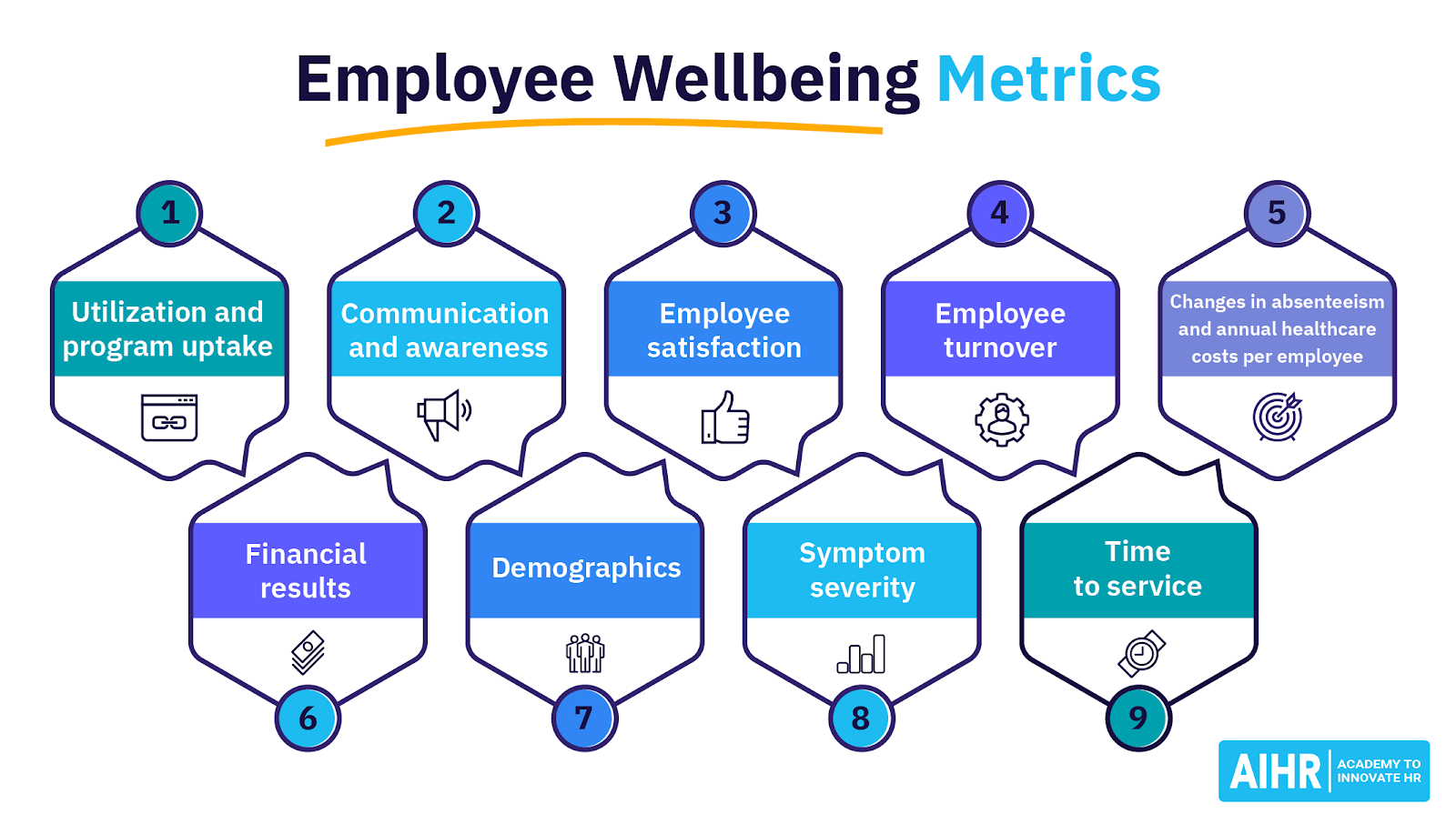
Image source: aihr.com
Building a Culture of Trust and Psychological Safety
A culture of trust and psychological safety is foundational for sustaining morale, as it empowers employees to voice concerns, share ideas, and take risks without fear of retribution. Research by Google’s Project Aristotle revealed that psychological safety was the most critical factor in high-performing teams, enabling a 35% increase in collaborative problem-solving.
To foster this environment, organizations can implement transparent decision-making frameworks. For example, GitLab’s open documentation of policies and decisions ensures employees understand the rationale behind leadership actions, building trust and reducing ambiguity. This approach has contributed to GitLab’s employee satisfaction score exceeding 90%.
A unique model, the Trust and Safety Index (TSI), can measure organizational trust by aggregating metrics such as employee feedback, retention rates, and participation in decision-making. Companies scoring above 85 on the TSI, like Atlassian, report higher innovation rates and a 25% reduction in turnover.
Contrary to traditional beliefs, trust is not built solely through leadership charisma but through consistent, inclusive practices. For instance, Atlassian’s “Team Playbook” encourages structured team retrospectives, ensuring all voices are heard.
Looking ahead, integrating AI-driven sentiment analysis into feedback systems can proactively identify trust gaps, enabling organizations to address issues before they escalate, ensuring long-term psychological safety.
Continuous Professional Development Opportunities
Continuous professional development (CPD) is a cornerstone of sustained employee morale, as it aligns individual growth with organizational goals. A focused approach involves tailored learning pathways that address both current job requirements and future career aspirations. For instance, Adobe’s Learning Fund reimburses employees for tuition and professional certifications, resulting in a 94% employee satisfaction rate with development opportunities.
A unique metric, the Development Engagement Index (DEI), can measure the impact of CPD programs by tracking participation rates, skill acquisition, and career progression. Companies scoring above 85 on the DEI, such as Boston Beer Co., report a 15% reduction in turnover and increased innovation due to enhanced employee capabilities.
Emerging trends highlight the importance of microlearning platforms. Tools like Axonify deliver bite-sized, on-demand training, enabling employees to upskill without disrupting workflows. This approach is particularly effective in industries with rapid technological advancements, such as fintech and healthcare.
Contrary to traditional beliefs, CPD is not solely about technical skills. Programs that integrate soft skills training, such as emotional intelligence and leadership, foster collaboration and resilience.
Looking forward, organizations should adopt adaptive CPD frameworks that combine AI-driven skill gap analysis, mentorship programs, and real-time feedback to ensure development remains relevant and impactful.



